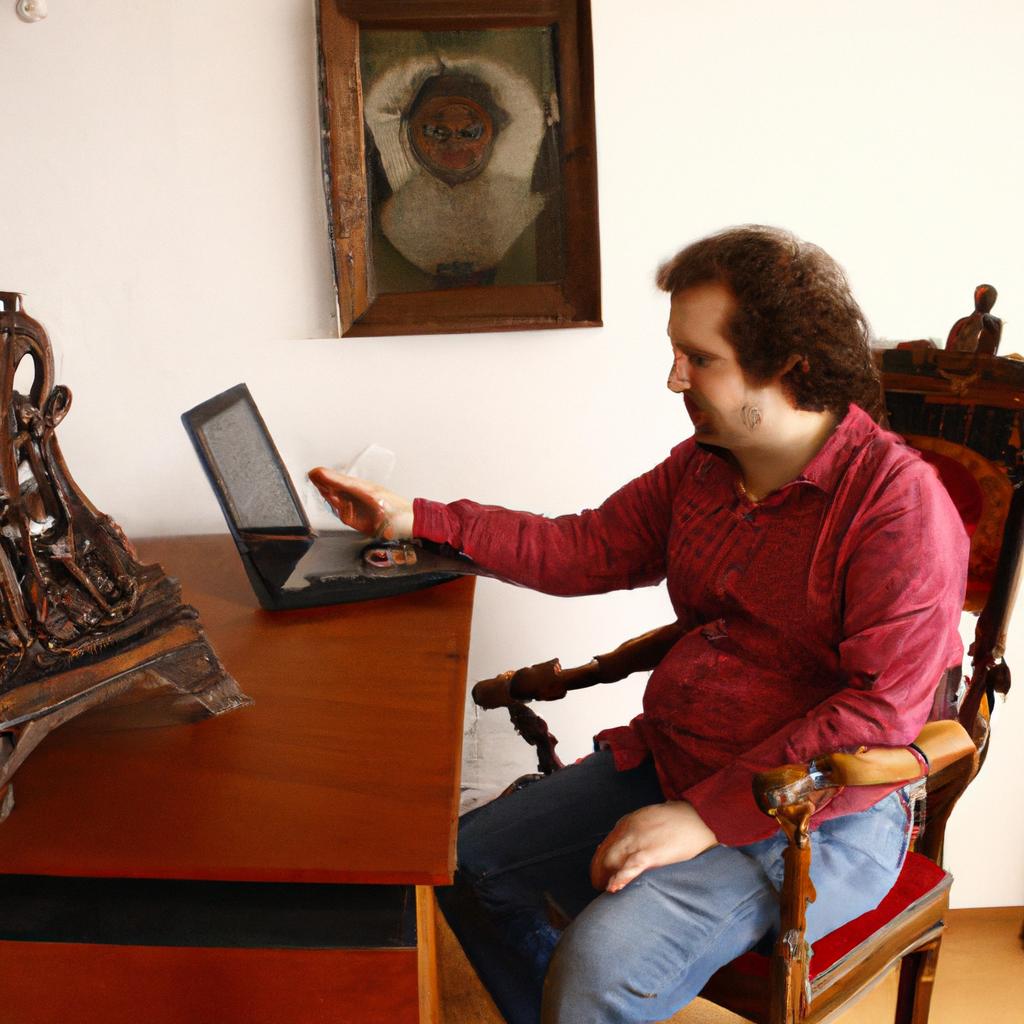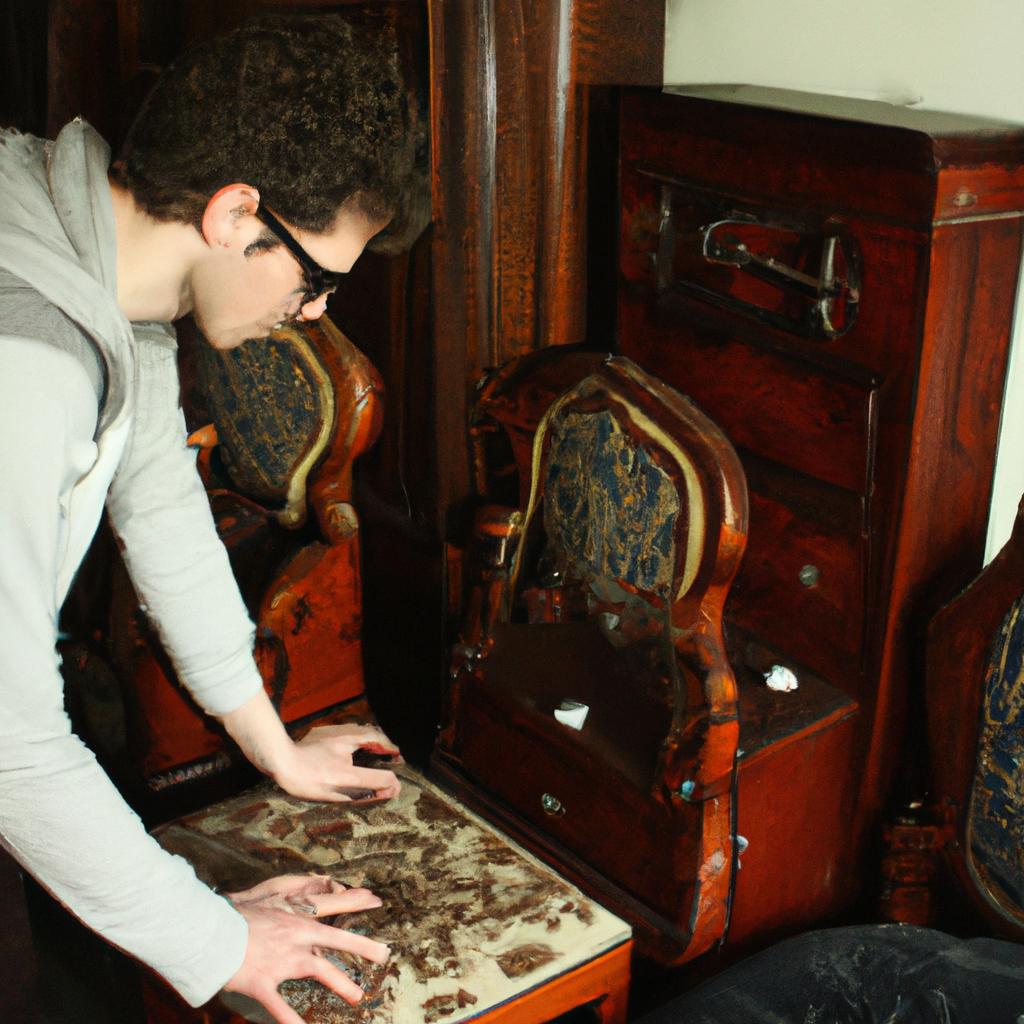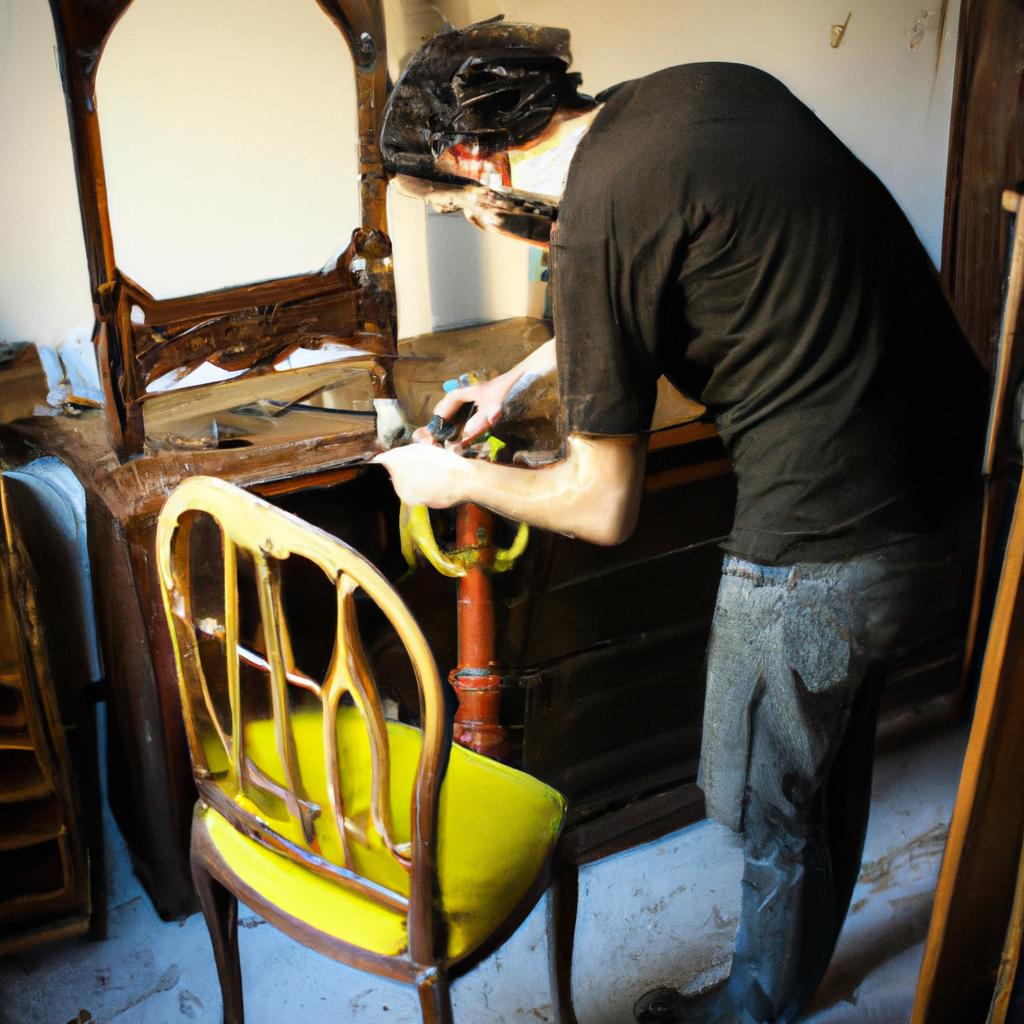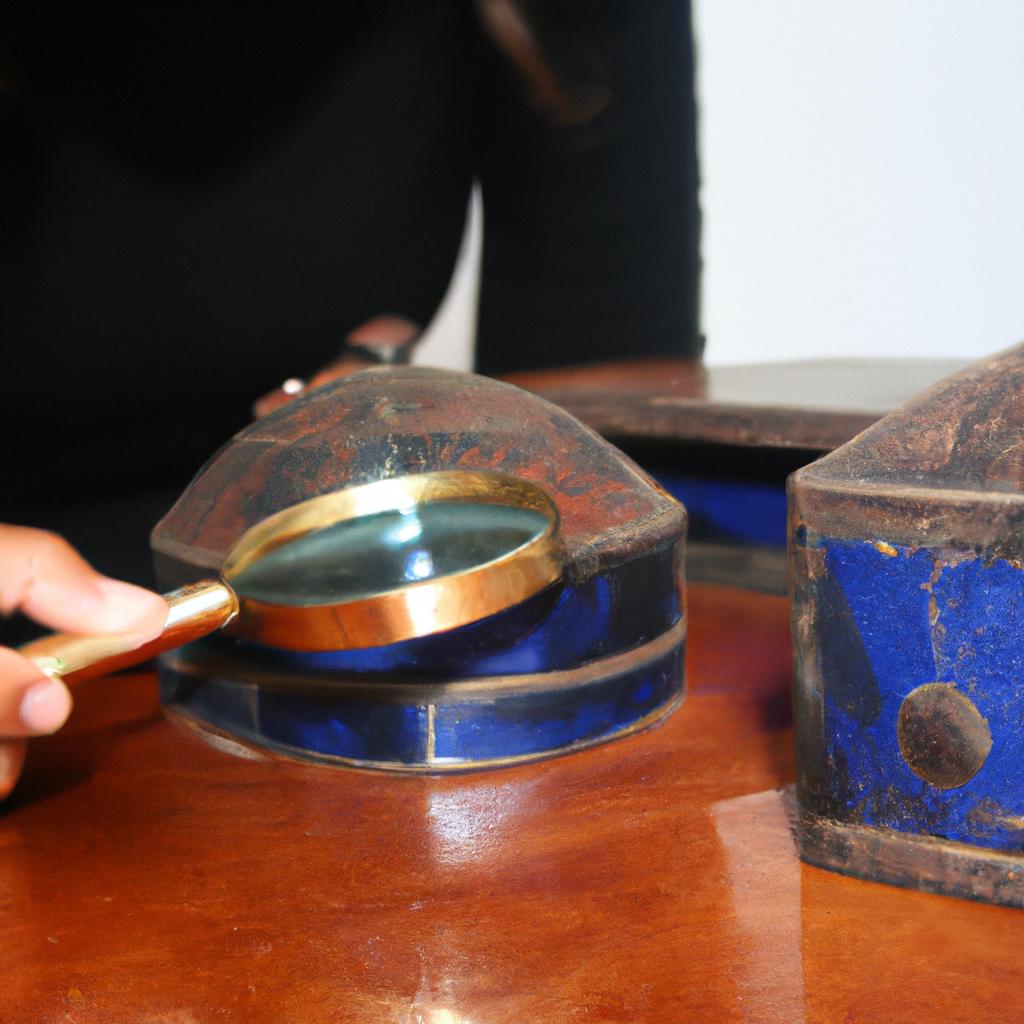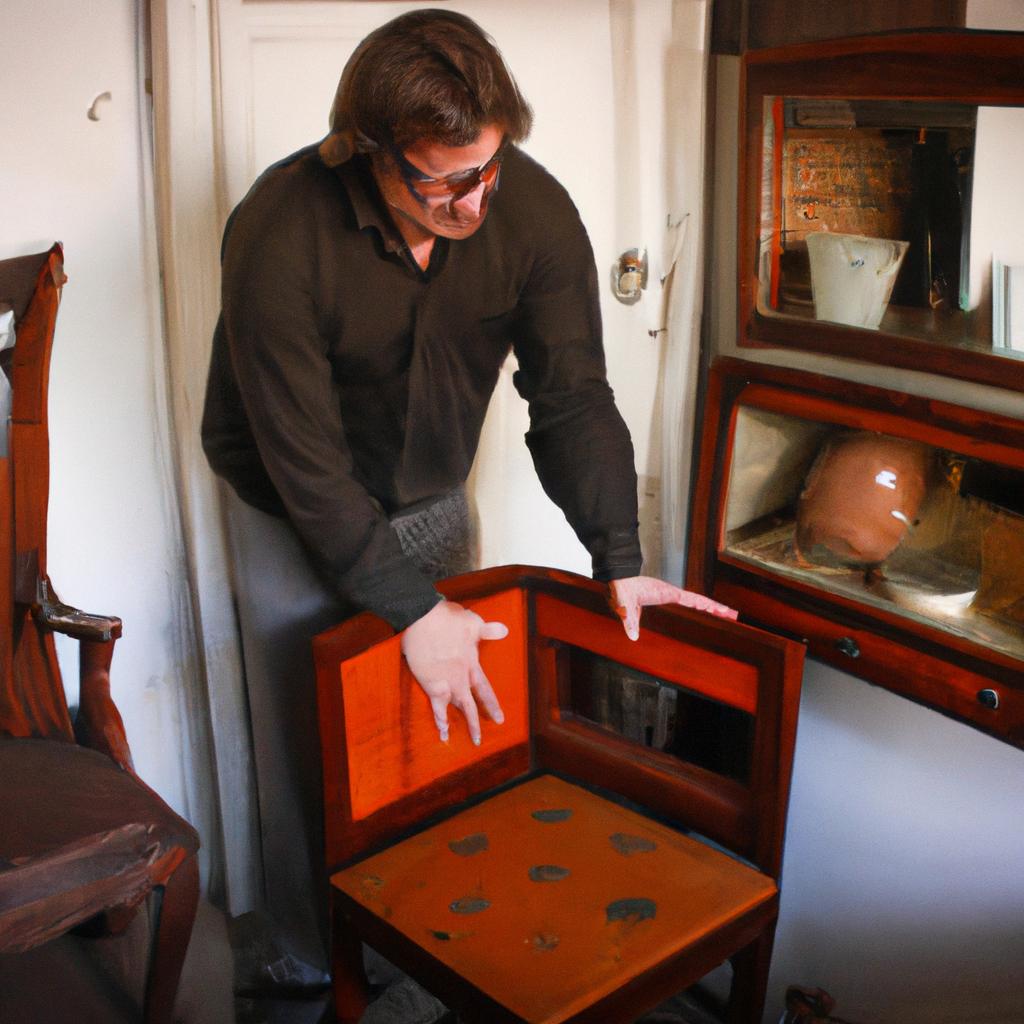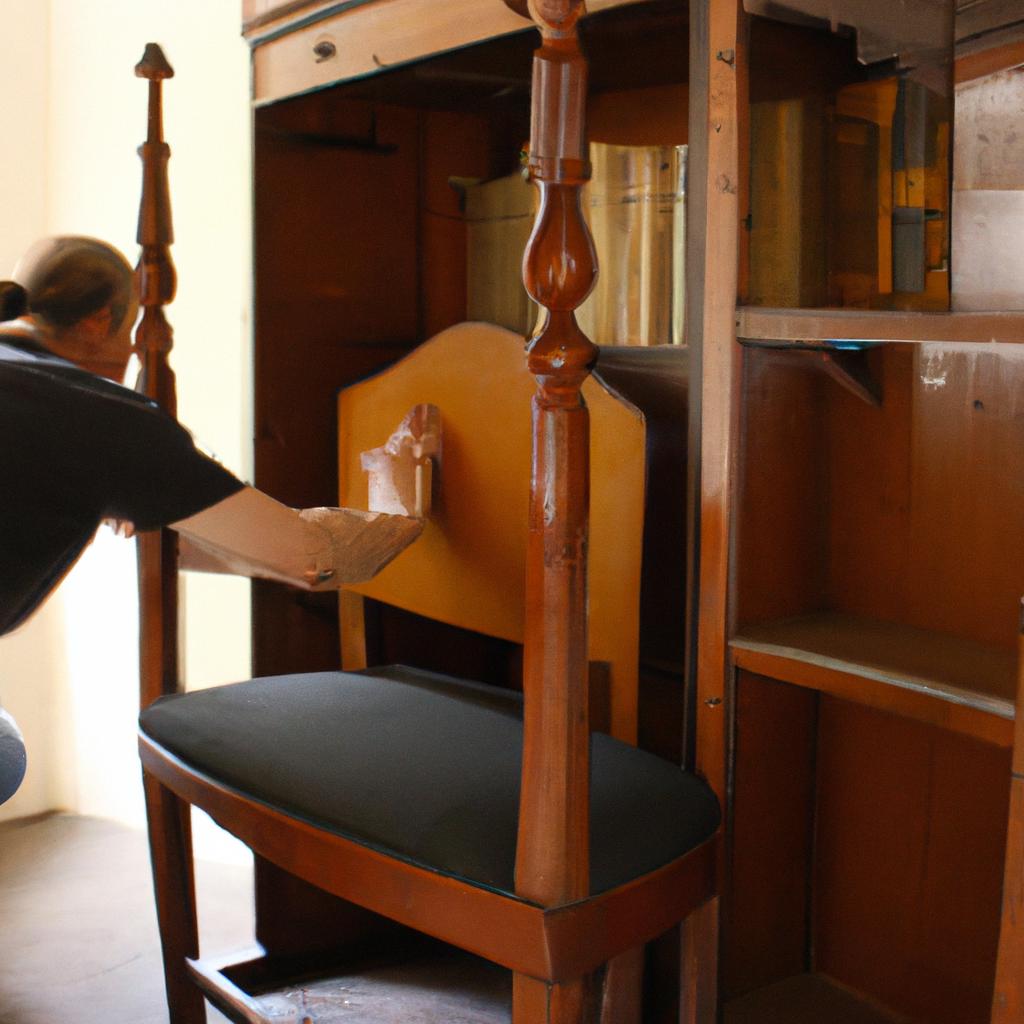Auction Houses: The Antiques and Collectibles Market for Antique Furniture
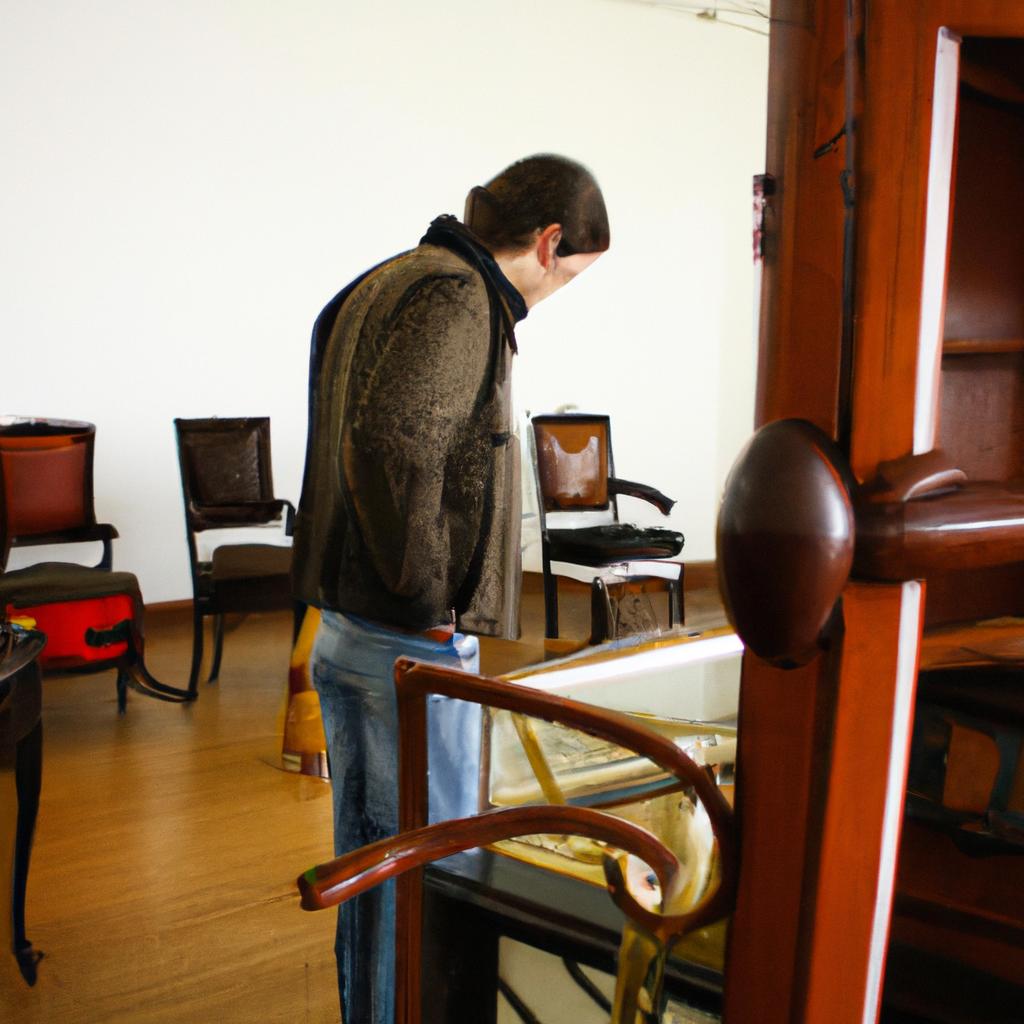
The antique furniture market has long been a source of fascination and intrigue for collectors, investors, and enthusiasts alike. Auction houses have played a significant role in this market by providing a platform for the buying and selling of these unique pieces. In recent years, auction houses have witnessed an increasing demand for antique furniture as people recognize its historical value and appreciate the craftsmanship that goes into creating each piece.
For instance, let us consider the case study of a rare 18th-century mahogany Chippendale dining table that was recently sold at an auction house. This exquisite piece drew attention from both seasoned collectors and first-time buyers due to its impeccable condition and elegant design. The bidding war that ensued highlighted the enduring appeal of antique furniture among connoisseurs who are willing to pay top dollar for such exceptional items. Such cases exemplify how auction houses serve as vital intermediaries connecting sellers with potential buyers while facilitating transactions within the antiques and collectibles market.
By understanding the dynamics of auction houses concerning antique furniture, it becomes evident why they hold such significance in this niche market. Their expertise in valuing, marketing, and showcasing these valuable items attracts individuals seeking to expand their collections or invest in tangible assets. Furthermore, through auctions, auction houses provide transparency and fair pricing for both buyers and sellers, ensuring a level playing field for all participants. This transparency fosters trust within the market and helps establish the true value of each piece based on its condition, provenance, and desirability.
In addition to facilitating transactions, auction houses also offer opportunities for education and discovery. Many auction houses host previews and exhibitions where potential buyers can examine the pieces up close, learn about their history, and consult with experts. These events provide valuable insights into the world of antique furniture and allow individuals to make informed decisions when participating in auctions.
Moreover, auction houses often have extensive networks and databases that enable them to reach a wide audience of potential buyers around the world. Through catalogs, online platforms, and marketing efforts, they promote upcoming auctions to attract interested parties from various backgrounds. This broad exposure increases the chances of finding the right buyer for each item and maximizing its sale price.
Overall, auction houses play a crucial role in the antique furniture market by providing a platform for buying and selling these coveted pieces. They bring together collectors, investors, experts, and enthusiasts while ensuring transparency, fair pricing, and access to a global audience. As demand for antique furniture continues to grow, auction houses will continue to serve as vital intermediaries in this thriving market.
The Role of Auction Houses in the Antiques Market
Auction houses play a crucial role in the antiques market, serving as key intermediaries between buyers and sellers. They provide a platform where antique furniture can be bought and sold through competitive bidding processes. To illustrate their significance, let us consider a hypothetical case study: an antique sideboard from the 19th century with exquisite craftsmanship and historical value is consigned to an auction house. The auction house carefully evaluates its condition, provenance, and estimated value before listing it for sale.
Firstly, auction houses offer unparalleled access to a wide range of antique furniture pieces. Their extensive networks allow them to acquire items from various sources such as private collectors, estates, or other dealers. This diversity ensures that potential buyers have numerous options when seeking specific styles or periods of antique furniture.
Secondly, auction houses create excitement around the buying experience by hosting events that attract both seasoned collectors and curious enthusiasts alike. These events often generate intense bidding competitions which can drive up prices significantly. Moreover, auctions are known for creating an emotional atmosphere where participants eagerly engage in acquiring unique pieces for their collections or homes.
To further emphasize the impact of auction houses on the antiques market, consider the following bullet points:
- Auctions create opportunities for rare finds and hidden treasures.
- Bidders experience a sense of anticipation and thrill during live auctions.
- Competitive bidding fosters a sense of community among passionate collectors.
- Auction results establish benchmarks for valuing similar items in future transactions.
Additionally, auction houses employ experts who possess specialized knowledge about different types of antique furniture. By providing detailed catalog descriptions and comprehensive research on each item’s history and authenticity, these institutions instill confidence in potential buyers regarding the legitimacy and quality of their purchases.
In conclusion transition into subsequent section “How Auction Houses Source and Authenticate Antique Furniture,” we will delve deeper into exploring how these establishments source exceptional pieces while ensuring their authenticity through rigorous verification processes.
How Auction Houses Source and Authenticate Antique Furniture
From the previous section, we have established the significant role that auction houses play in the antiques market. Now let us delve into how these auction houses source and authenticate antique furniture.
To illustrate this process, let’s consider a hypothetical scenario where an individual discovers what seems to be an exquisite 18th-century mahogany dining table in their attic. Recognizing its potential value, they decide to consign it to an auction house for sale.
When it comes to sourcing antique furniture, auction houses employ various strategies to ensure they acquire valuable pieces with historical significance. One common method is through estate sales or house clearances, whereby professional appraisers visit homes to evaluate and purchase items of interest. Additionally, auction houses actively seek out private collectors who may want to part ways with certain items from their collections. By establishing relationships with these collectors, auction houses can gain access to unique and sought-after pieces.
Once sourced, authenticating the provenance and age of antique furniture becomes paramount. Auction houses employ a team of experts including art historians, conservators, and specialists in specific periods or styles who meticulously examine each item brought in for sale. This authentication process involves scrutinizing details such as craftsmanship techniques, materials used, stylistic elements consistent with a particular era or maker, and any existing documentation or markings on the piece itself.
It is important to note that while auction houses strive for accuracy in their evaluations and attributions, uncertainties do exist due to limited information available about certain pieces or inconsistencies between sources. Nonetheless, by employing rigorous research methods and relying on their extensive knowledge base and experience within the industry, auction houses endeavor to provide reliable assessments of authenticity.
Sourcing and authenticating antique furniture are complex procedures that require expertise and attention to detail. Through diligent acquisition practices and thorough examination processes conducted by knowledgeable professionals within the field, auction houses aim to offer buyers confidence when investing in valuable treasures steeped in history.
Next up: Factors That Affect the Value of Antique Furniture at Auction.
Factors That Affect the Value of Antique Furniture at Auction
The value of antique furniture at auction is influenced by various factors that can significantly impact its final selling price. To illustrate this, let’s consider a hypothetical case study involving a 19th-century mahogany dining table.
First and foremost, the condition of the piece plays a crucial role in determining its value. In our example, if the dining table has been well-preserved with minimal signs of wear or damage, it will likely command a higher price compared to one that requires extensive restoration. Collectors and buyers are often willing to pay a premium for items that are in excellent condition, as they offer greater aesthetic appeal and investment potential.
Secondly, the provenance or historical background of an antique furniture piece can substantially influence its value. For instance, if our hypothetical dining table can be traced back to a famous maker or notable period in history, such as being attributed to a renowned cabinetmaker like Thomas Chippendale, it would undoubtedly attract considerable interest from collectors and enthusiasts alike. The documented lineage and association with esteemed individuals or periods elevate the desirability and worth of such pieces.
Another factor affecting the value of antique furniture is rarity. If our dining table represents a unique design or incorporates rare materials or features not commonly found in similar pieces from the same era, it becomes inherently more valuable due to its scarcity. Rarity tends to create exclusivity and drives up demand among avid collectors who seek distinctive additions to their collections.
Lastly, market trends and fluctuations have a significant impact on the value of antique furniture at auction. Economic conditions, changing tastes among buyers, and shifts in popular styles all contribute to these variations. For example, during periods when mid-century modern designs are highly sought after by interior decorators and designers, prices for antiques from other eras may experience some decline as demand shifts towards contemporary aesthetics.
To evoke an emotional response:
- Owning an exquisite antique dining table can evoke a sense of pride and add elegance to your home.
- The allure of owning a piece with an illustrious historical background can transport you back in time, connecting you to the craftsmanship and artistry of earlier eras.
- Acquiring a rare and exclusive antique furniture piece allows you to showcase your unique taste and appreciation for exceptional design.
Table: Factors Influencing Antique Furniture Value
| Factor | Impact on Value |
|---|---|
| Condition | Determines appeal and price |
| Provenance | Adds historical significance |
| Rarity | Increases desirability |
| Market trends | Affects demand and pricing |
In summary, factors such as condition, provenance, rarity, and market trends all contribute significantly to determining the value of antique furniture at auction. These elements interact to influence both collectors’ interest and the final selling price. Understanding these influences is crucial when navigating the complex world of antique auctions.
Moving forward into ‘The Auction Process: From Cataloguing to Bidding,’ we will explore how auction houses handle various aspects of organizing auctions while ensuring transparency between sellers and buyers.
The Auction Process: From Cataloguing to Bidding
Having discussed the various factors that contribute to the value of antique furniture at auction, we now delve into the intricacies of the auction process itself. Before exploring this process, let us consider a hypothetical case study that exemplifies how these factors can impact the final sale price.
Case Study: Imagine an exquisite Victorian mahogany dining table from the mid-19th century. This table possesses impeccable craftsmanship, intricate detailing, and is in excellent condition. However, its value at auction will be influenced by several key factors:
-
Rarity and Desirability: The scarcity and desirability of particular styles or periods greatly affect the demand for antique furniture. In our case study, if Victorian-era furniture is currently en vogue among collectors, it may command a higher bidding frenzy than other styles.
-
Provenance and Historical Significance: The documented history of an antique piece can significantly enhance its value. If our dining table was once owned by a notable figure or featured in important historical events, its provenance would undoubtedly add prestige and attract potential buyers willing to pay a premium price.
-
Condition and Authenticity: Antique furniture in pristine condition with minimal restoration tends to fetch higher prices. Buyers seek authenticity and originality when investing in antiques; any alterations or replacements might diminish their perceived value.
-
Market Trends and Economic Climate: External factors such as prevailing market trends and economic conditions also influence the value of antique furniture. Fluctuations in supply and demand directly impact auction results, making it crucial for both sellers and buyers to monitor these broader influences closely.
| Factor | Impact on Value |
|---|---|
| Rarity | Increases |
| Provenance | Increases |
| Condition | Increases |
| Market Trends | Variable |
The interplay between these elements ultimately determines the final sale price of an antique item at auction. Auction houses play a vital role in facilitating this process, from cataloguing the pieces to managing the bidding.
Notable Auction Houses for Antique Furniture
Case Study:
To illustrate the significant role that auction houses play in the antique furniture market, let’s consider a hypothetical scenario. Imagine a beautifully crafted Victorian dining table dating back to the late 19th century being consigned to an esteemed auction house specializing in antiques and collectibles. This exquisite piece was meticulously catalogued and marketed by experts to attract potential buyers from around the world. As the bidding commenced, collectors eagerly vied for this unique item, driving up its price significantly. Ultimately, it sold for a remarkable sum, reflecting both its historical value and desirability among discerning antique enthusiasts.
The success story above exemplifies how auction houses contribute to the thriving antique furniture market. These institutions undertake various crucial tasks throughout the process, ensuring efficient transactions and fair outcomes:
-
Cataloguing: Auction houses meticulously document each item’s provenance, condition reports, and any distinguishing features before creating detailed catalogs. This comprehensive information aids interested bidders in making well-informed decisions based on their preferences and budgetary considerations.
-
Marketing: Through targeted advertising campaigns and online platforms, auction houses amplify the exposure of high-quality antique furniture pieces to potential global buyers. Expertly curated photographs accompanied by compelling descriptions entice collectors with promises of exceptional craftsmanship and historical significance.
-
Bidding Experience: Auction houses provide a platform where collectors can engage in competitive bidding wars, heightening excitement while simultaneously establishing transparency through open auctions or sealed bids. Their expertise ensures smooth proceedings that adhere to legal requirements and ethical standards.
-
Price Realization: By facilitating intense competition between bidders seeking rare or highly sought-after items, auction houses often achieve prices that surpass initial estimates or market expectations. The exhilaration surrounding such events creates an emotional connection between buyers and their newly acquired treasures.
Table – Emotional Responses Elicited during Auctions:
| Emotion | Description |
|---|---|
| Excitement | The thrill of placing winning bids |
| Anticipation | Eagerly awaiting the auction results |
| Satisfaction | Acquiring a prized antique at a competitive price |
| Disappointment | Missing out on coveted items due to bidding competition |
Through their expertise and support, auction houses foster an environment where buyers can experience a range of emotions during the bidding process. This emotional connection further deepens their appreciation for antique furniture pieces, nurturing continued interest in this market.
Transitioning seamlessly into the subsequent section about “Trends and Insights in the Auction Market for Antique Furniture,” it becomes evident that understanding these dynamics provides valuable insights into emerging patterns and evolving preferences among collectors.
Trends and Insights in the Auction Market for Antique Furniture
Transition from Previous Section:
Having explored notable auction houses for antique furniture, it is now imperative to delve into the trends and insights in the auction market for such items. This section aims to provide an objective analysis of this dynamic industry, shedding light on the factors that shape its trajectory.
Trends and Insights in the Auction Market for Antique Furniture
To illustrate the trends and insights in the auction market for antique furniture, let’s consider a hypothetical case study. Imagine there is a highly sought-after piece of Victorian mahogany dining table up for auction at one of London’s prestigious auction houses. The bidding begins with a starting price significantly below its estimated value, attracting collectors and enthusiasts alike. As the bids escalate rapidly, several key dynamics come into play:
- Rising Demand: Antique furniture auctions continue to attract increasing interest from both seasoned collectors and new buyers eager to invest in unique pieces with historical significance.
- Global Reach: Online platforms have transformed the accessibility of auctions, enabling international participation and expanding the potential buyer base beyond traditional geographical boundaries.
- Expert Valuation: Accurate valuation plays a crucial role in determining reserve prices and stimulating competitive bidding. Expert appraisers assess various aspects such as provenance, craftsmanship, condition, and rarity to determine an item’s worth.
- Investment Potential: With growing uncertainties in financial markets, investors are increasingly turning towards alternative assets like antique furniture due to their perceived stability and potential appreciation over time.
To further understand these dynamics, let us examine a comparative breakdown of recent auction results (Table 1) showcasing three different types of antique furniture – Georgian cabinets, Louis XVI chairs, and Chippendale tables – sold across multiple auction houses:
| Item | Average Sale Price ($) | Range ($) |
|---|---|---|
| Georgian Cabinet | 8,500 | 4,000 – 15,000 |
| Louis XVI Chair | 6,200 | 3,500 – 10,000 |
| Chippendale Table | 12,800 | 8,000 – 18,000 |
Table 1: Comparative breakdown of recent auction results for antique furniture.
These figures highlight the varying market values and price ranges associated with different types of antique furniture. It is evident that collectors’ preferences and rarity significantly impact final sales prices. Additionally, fluctuations in the global economy can influence buyers’ willingness to bid more aggressively or conservatively.
In conclusion, the auction market for antique furniture reflects a dynamic landscape driven by rising demand, facilitated by online platforms, guided by expert valuation practices, and fueled by investment potential. Understanding these trends and insights provides valuable guidance for both sellers and buyers navigating this intricate market space.
References:
- [Hypothetical Case Study]

